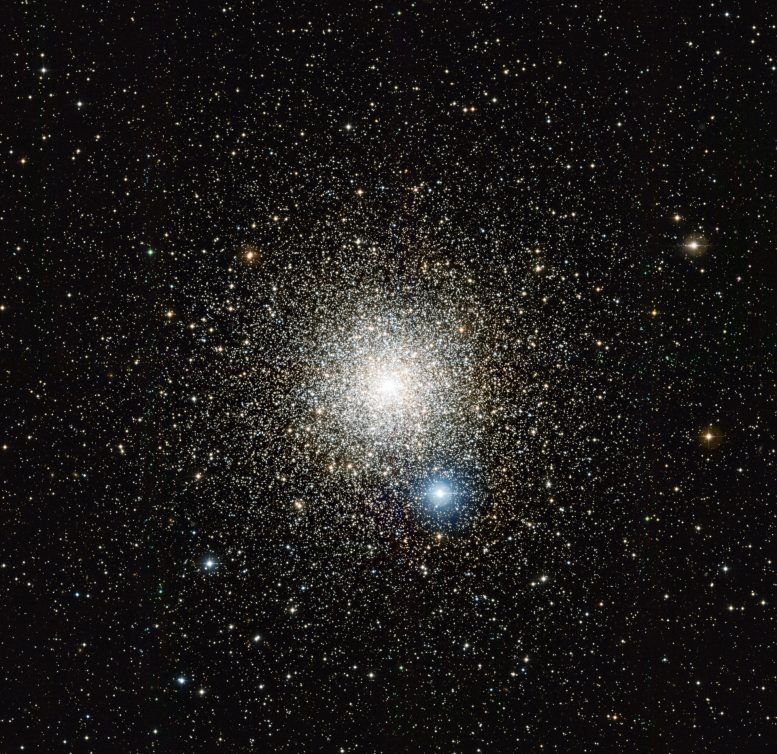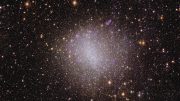
This image from the Wide Field Imager on the MPG/ESO 2.2-meter (7.2-foot) telescope at the La Silla Observatory in Chile shows the globular star cluster NGC 6752 in the southern constellation of Pavo (The Peacock). Studies of this cluster using ESO’s Very Large Telescope have unexpectedly revealed that many of the stars do not undergo mass-loss at the end of their lives. Credit: ESO
Researchers used ESO’s Very Large Telescope to carefully study the light coming from stars in the globular star cluster NGC 6752, finding that all of the AGB stars in the study were first generation stars with low levels of sodium and none of the higher-sodium second generation stars had become AGB stars at all.
Astronomers expect that stars like the Sun will blow off much of their atmospheres into space near the ends of their lives. But new observations of a huge star cluster made using ESO’s Very Large Telescope have shown — against all expectations — that a majority of the stars studied simply did not get to this stage in their lives at all. The international team found that the amount of sodium in the stars was a very strong predictor of how they ended their lives.
The way in which stars evolve and end their lives was for many years considered to be well understood. Detailed computer models predicted that stars of a similar mass to the Sun would have a period towards the ends of their lives — called the asymptotic giant branch, or AGB[1] — when they undergo a final burst of nuclear burning and puff off a lot of their mass in the form of gas and dust.
This expelled material [2] goes on to form the next generations of stars and this cycle of mass loss and rebirth is vital to explain the evolving chemistry of the Universe. This process is also what provides the material required for the formation of planets — and indeed even the ingredients for organic life.
A close look at the globular star cluster NGC 6752. This video provides a close look at a new image from the Wide Field Imager on the MPG/ESO 2.2-meter telescope at the La Silla Observatory in Chile. It shows the globular star cluster NGC 6752 in the southern constellation of Pavo (The Peacock). Studies of this cluster using ESO’s Very Large Telescope have unexpectedly revealed that many of the stars do not undergo mass loss at the end of their lives.
But when Australian stellar theory expert Simon Campbell of the Monash University Center for Astrophysics, Melbourne, scoured old papers he found tantalizing suggestions that some stars may somehow not follow the rules and might skip the AGB phase entirely. He takes up the story:
“For a stellar modeling scientist, this suggestion was crazy! All stars go through the AGB phase according to our models. I double-checked all the old studies but found that this had not been properly investigated. I decided to investigate myself, despite having little observational experience.”
Campbell and his team used ESO’s Very Large Telescope (VLT) to very carefully study the light coming from stars in the globular star cluster NGC 6752 in the southern constellation of Pavo (The Peacock). This vast ball of ancient stars contains both a first generation of stars and a second that formed somewhat later.[3] The two generations can be distinguished by the amount of sodium they contain — something that the very high-quality VLT data can be used to measure.
“FLAMES, the multi-object high-resolution spectrograph on the VLT, was the only instrument that could allow us to get really high-quality data for 130 stars at a time. And it allowed us to observe a large part of the globular cluster in one go,” adds Campbell.
The results were a surprise — all of the AGB stars in the study were first-generation stars with low levels of sodium and none of the higher-sodium second-generation stars had become AGB stars at all. As many as 70% of the stars were not undergoing the final nuclear burning and mass-loss phase.[4,5]
“It seems stars need to have a low-sodium “diet” to reach the AGB phase in their old age. This observation is important for several reasons. These stars are the brightest stars in globular clusters — so there will be 70% fewer of the brightest stars than theory predicts. It also means our computer models of stars are incomplete and must be fixed!” concludes Campbell.
The team expects that similar results will be found for other star clusters and further observations are planned.
Notes
- AGB stars get their odd name because of their position on the Hertzsprung Russell diagram, a plot of the brightness of stars against their colors.
- For a short period of time, this ejected material is lit up by the strong ultraviolet radiation from the star and creates a planetary nebula (see for instance eso1317).
- Although the stars in a globular cluster all formed at about the same time, it is now well established that these systems are not as simple as they once thought to be. They usually contain two or more populations of stars with different amounts of light chemical elements such as carbon, nitrogen and — crucially for this new study — sodium.
- It is thought that stars that skip the AGB phase will evolve directly into helium-white dwarf stars and gradually cool down over many billions of years.
- It is not thought that the sodium itself is the cause of the different behavior, but must be strongly linked to the underlying cause — which remains mysterious.
Reference: “Sodium content as a predictor of the advanced evolution of globular cluster stars” by Simon W. Campbell, Valentina D’Orazi, David Yong, Thomas N. Constantino, John C. Lattanzio, Richard J. Stancliffe, George C. Angelou, Elizabeth C. Wylie-de Boer and Frank Grundahl, 29 May 2013, Nature.
DOI: 10.1038/nature12191









Hydrogen, Helium, Lithium, Berylium, Boron, Carbon, Nitrogen, Oxygen, Flourine, Neon, SODIUM, Magnesium, Aluminium, Silicon, Phosophoros, Sulphur, Chlorine, Argon, Potassium, Calcium… are the twenty in order of the Periodic table. These are the elements of upper atmosphere of any Planet including the Hydrocarbons and all living beings with amino acids. The order of synthesis should be in the same order from a star starting from Hydrogen and Helium. The relative abundance is a matter of the properties of the chemistry of the elements concerned. All other heavier elements are formed in the inner core and with great amount of radiation and stress. The death of a Star before becoming a Nebulous cloud should also follow the unwinding of this spiral, finally culminating in Hydrogen and Helium going back to the scrap. Initially the abundance of Carbon, Nitrogen and Oxygen were studied and it is now the study of Sodium in this order that decides the age of the Star. Planet chemistry is going in a full cycle and rewinding itself. Thank You.